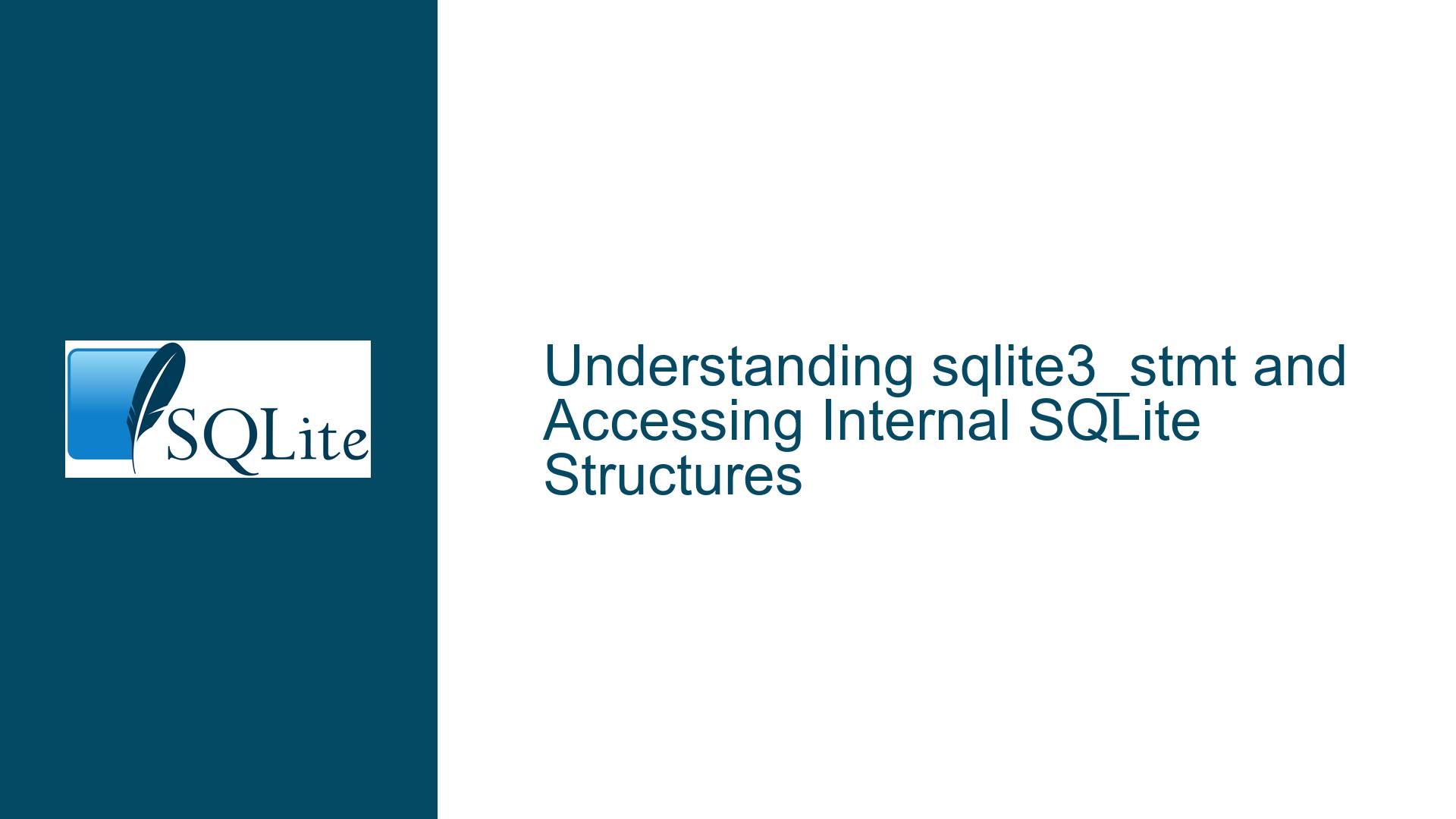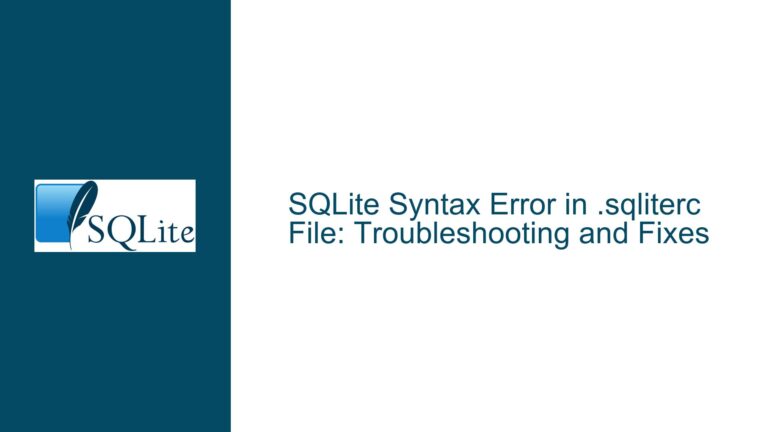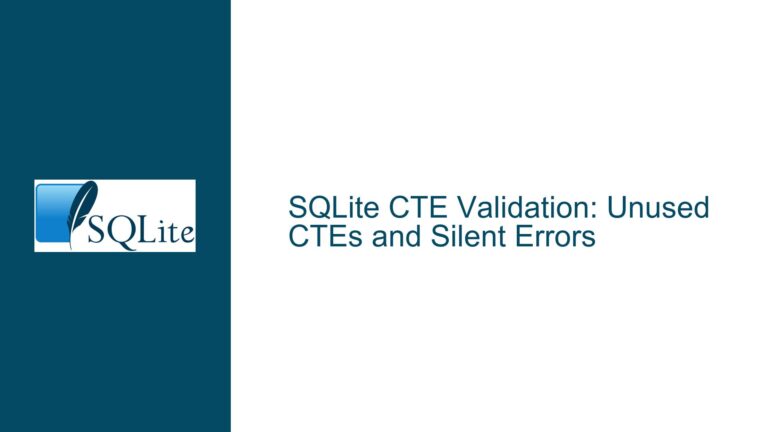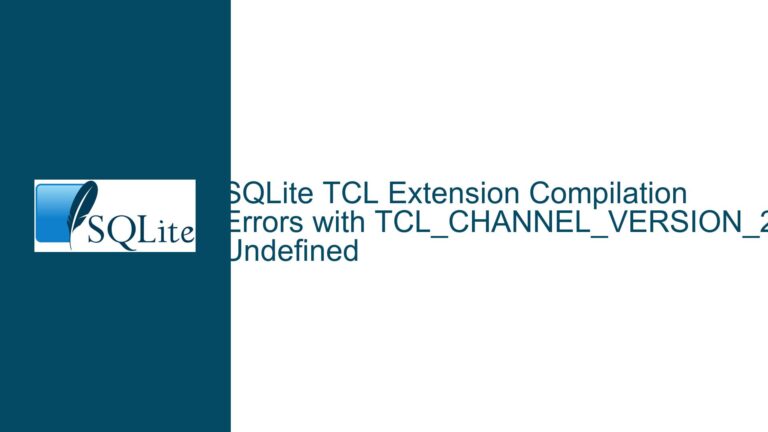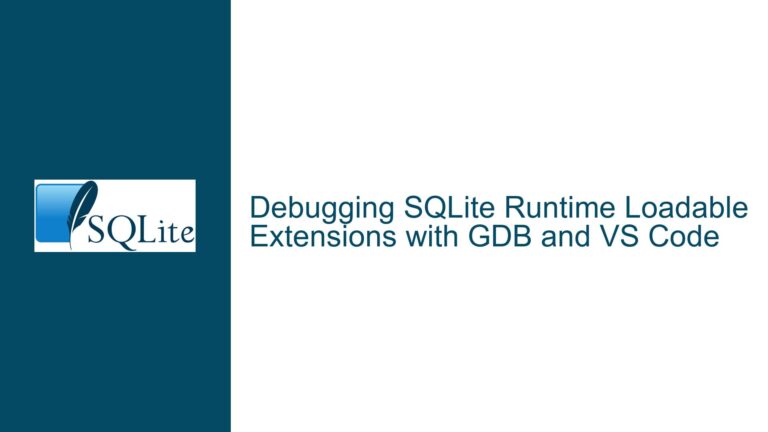sqlite3_stmt and Accessing Internal SQLite Structures
Issue Overview: Accessing Internal SQLite Structures for Debugging
The core issue revolves around understanding the definition and usage of the sqlite3_stmt structure in SQLite, as well as accessing internal SQLite structures such as Expr, Select, and ExprList for debugging purposes. The sqlite3_stmt structure is a critical component in SQLite’s API, representing a prepared statement object. However, its definition is not explicitly provided in the public header file sqlite3.h. Instead, it is defined as an opaque type, meaning that its internal details are hidden from the user. This design choice is intentional, as SQLite’s developers aim to maintain a stable API while allowing internal implementations to evolve.
The user in this scenario is attempting to use internal debugging functions such as sqlite3TreeViewExpr, sqlite3TreeViewSelect, and sqlite3TreeViewExprList. These functions require access to internal structures like Expr, Select, and ExprList, which are not part of the public API. These structures are defined in the internal header file sqliteInt.h, which is not included in the public distribution of SQLite. This creates a challenge for developers who wish to leverage these internal structures for debugging or advanced use cases.
The sqlite3_stmt structure is essentially a pointer to an instance of the Vdbe (Virtual Database Engine) structure, which is SQLite’s internal representation of a prepared statement. The Vdbe structure contains a wealth of information about the SQL statement being executed, including its parse tree, execution plan, and runtime state. To access the internal components of a prepared statement, such as the parse tree (Expr), the select statement (Select), or the expression list (ExprList), one must navigate through the Vdbe and Parse structures.
Possible Causes: Opaque Structures and Internal APIs
The primary cause of the issue is the opaque nature of the sqlite3_stmt structure and the fact that the internal structures (Expr, Select, ExprList, etc.) are not part of SQLite’s public API. SQLite’s developers have deliberately chosen to keep these structures internal to maintain API stability and prevent users from relying on implementation details that may change in future versions. This design philosophy is common in software libraries, where the public API is carefully curated to provide a stable interface while allowing internal implementations to evolve.
Another contributing factor is the lack of documentation for internal structures and functions. While SQLite’s public API is well-documented, the internal structures and functions are not intended for external use and therefore lack detailed documentation. This makes it challenging for developers to understand how to access and use these internal components, even when they have access to the source code.
The user’s attempt to use internal debugging functions such as sqlite3TreeViewExpr and sqlite3TreeViewSelect highlights the need for access to internal structures. These functions are designed to provide a human-readable representation of the parse tree and select statement, which can be invaluable for debugging complex SQL queries. However, since these functions rely on internal structures, they are not part of the public API and are not intended for use by external developers.
Troubleshooting Steps, Solutions & Fixes: Accessing Internal Structures and Debugging
To address the issue of accessing internal SQLite structures for debugging, several steps can be taken. These steps involve understanding the internal organization of SQLite, accessing the necessary header files, and using the internal debugging functions.
Step 1: Understanding the Internal Organization of SQLite
The first step is to understand how SQLite is organized internally. SQLite’s source code is divided into several components, including the public API (sqlite3.h), the internal header file (sqliteInt.h), and the implementation files (sqlite3.c, vdbe.c, etc.). The public API provides the functions and structures that are intended for use by external developers, while the internal header file and implementation files contain the details of SQLite’s internal workings.
The sqlite3_stmt structure is defined as an opaque type in the public API, meaning that its internal details are hidden from the user. However, the actual definition of the structure can be found in the internal header file sqliteInt.h. The sqlite3_stmt structure is essentially a pointer to an instance of the Vdbe structure, which represents a prepared statement in SQLite’s Virtual Database Engine.
Step 2: Accessing the Internal Header File (sqliteInt.h)
To access the internal structures such as Expr, Select, and ExprList, you will need to include the internal header file sqliteInt.h in your code. This file contains the definitions of the internal structures and functions that are used by SQLite’s implementation. However, since sqliteInt.h is not part of the public API, it is not included in the standard distribution of SQLite. You will need to obtain the full source code of SQLite, which is available from the SQLite website.
Once you have the full source code, you can include sqliteInt.h in your project. This will give you access to the internal structures and functions that are needed for debugging. However, it is important to note that using internal structures and functions is not recommended for production code, as they are subject to change in future versions of SQLite.
Step 3: Navigating the Internal Structures
With access to sqliteInt.h, you can now navigate the internal structures to access the components of a prepared statement. The sqlite3_stmt structure is a pointer to an instance of the Vdbe structure, which contains the details of the prepared statement. The Vdbe structure includes a pointer to a Parse structure, which represents the parsed SQL statement.
The Parse structure contains the parse tree, which is represented by the Expr and Select structures. The Expr structure represents an expression in the parse tree, while the Select structure represents a SELECT statement. The ExprList structure represents a list of expressions, which is used in various parts of the parse tree.
To access the Expr, Select, and ExprList structures, you will need to navigate through the Vdbe and Parse structures. For example, to access the Expr structure, you would start with the sqlite3_stmt pointer, cast it to a Vdbe pointer, and then access the Parse structure. From there, you can access the Expr structure.
Step 4: Using Internal Debugging Functions
Once you have access to the internal structures, you can use the internal debugging functions such as sqlite3TreeViewExpr, sqlite3TreeViewSelect, and sqlite3TreeViewExprList. These functions provide a human-readable representation of the parse tree and select statement, which can be invaluable for debugging complex SQL queries.
To use these functions, you will need to pass the appropriate internal structures as parameters. For example, to use sqlite3TreeViewExpr, you would pass a pointer to an Expr structure. Similarly, to use sqlite3TreeViewSelect, you would pass a pointer to a Select structure.
It is important to note that these functions are not part of the public API and are not intended for use in production code. They are provided as a convenience for developers who are working with the SQLite source code and need to debug complex SQL queries.
Step 5: Building SQLite with Debugging Support
If you are working with the SQLite source code and need to use internal debugging functions, you may want to build SQLite with debugging support. This will enable additional debugging features, such as the ability to print the parse tree and select statement in a human-readable format.
To build SQLite with debugging support, you will need to modify the build configuration. This typically involves setting certain preprocessor macros, such as SQLITE_DEBUG, which enables additional debugging code in the SQLite source. You may also need to enable other debugging options, depending on your specific needs.
Once you have built SQLite with debugging support, you can use the internal debugging functions to print the parse tree and select statement. This can be particularly useful when debugging complex SQL queries, as it allows you to see the internal representation of the query and identify any issues.
Step 6: Handling Changes in Internal Structures
One of the challenges of using internal structures and functions is that they are subject to change in future versions of SQLite. This means that code that relies on internal structures may break when upgrading to a new version of SQLite.
To mitigate this risk, it is important to minimize the use of internal structures and functions in your code. If you must use internal structures, you should carefully review the SQLite source code and documentation to understand how the structures are used and how they may change in future versions.
Additionally, you should consider writing wrapper functions that abstract away the details of the internal structures. This can help to isolate your code from changes in the internal structures and make it easier to update your code when upgrading to a new version of SQLite.
Step 7: Exploring Alternative Debugging Approaches
While accessing internal structures and using internal debugging functions can be useful, it is not the only approach to debugging SQLite queries. There are several alternative approaches that may be more suitable, depending on your specific needs.
One alternative approach is to use SQLite’s built-in debugging tools, such as the EXPLAIN and EXPLAIN QUERY PLAN commands. These commands provide a high-level overview of how SQLite is executing a query, including the steps involved and the order in which they are executed. This can be useful for identifying performance issues and understanding how SQLite is processing a query.
Another alternative approach is to use a third-party debugging tool or library that provides additional debugging features. There are several tools available that can help with debugging SQLite queries, including graphical debuggers, query analyzers, and performance profiling tools. These tools can provide additional insights into how SQLite is executing a query and help to identify issues that may not be apparent from the SQLite source code.
Conclusion
Accessing internal SQLite structures for debugging can be a powerful tool for developers who need to understand the inner workings of SQLite. However, it is important to approach this task with caution, as internal structures and functions are not part of the public API and are subject to change in future versions of SQLite. By understanding the internal organization of SQLite, accessing the necessary header files, and using internal debugging functions, you can gain valuable insights into how SQLite processes SQL queries. However, it is also important to consider alternative debugging approaches and minimize the use of internal structures in your code to ensure compatibility with future versions of SQLite.
